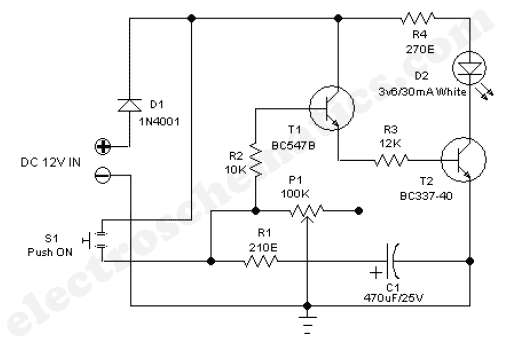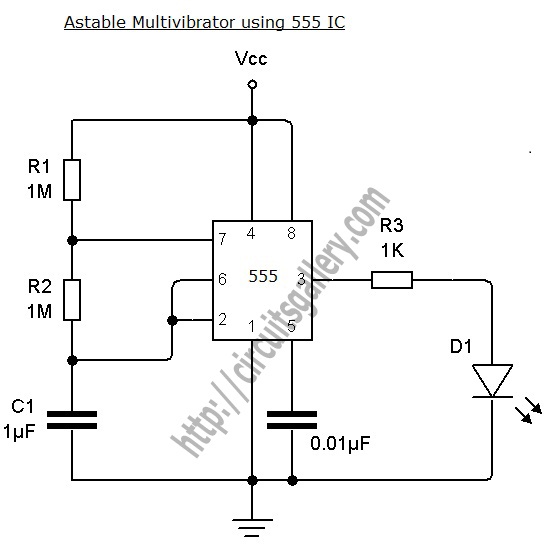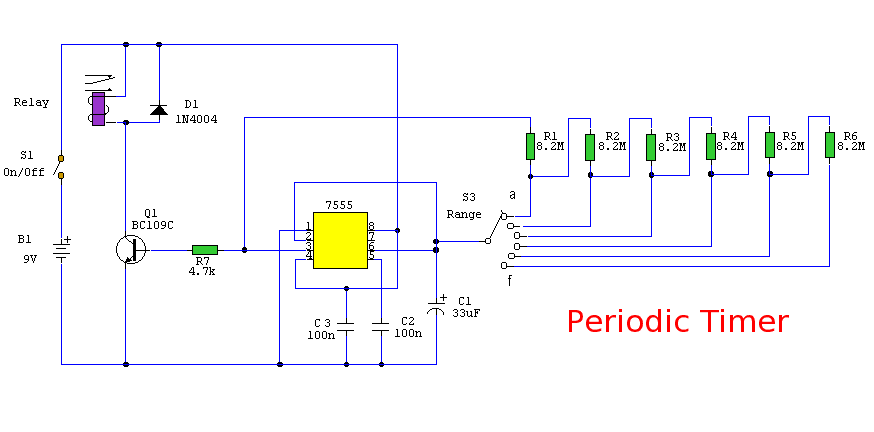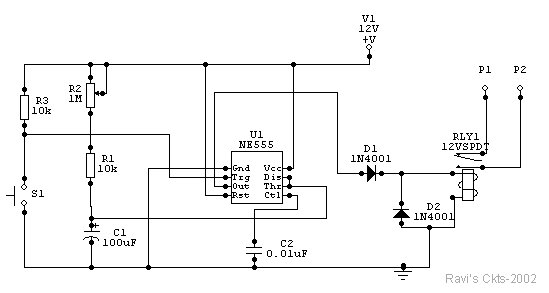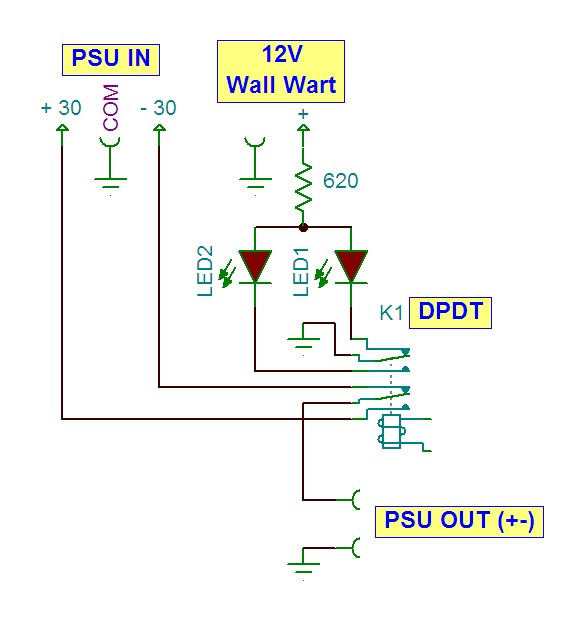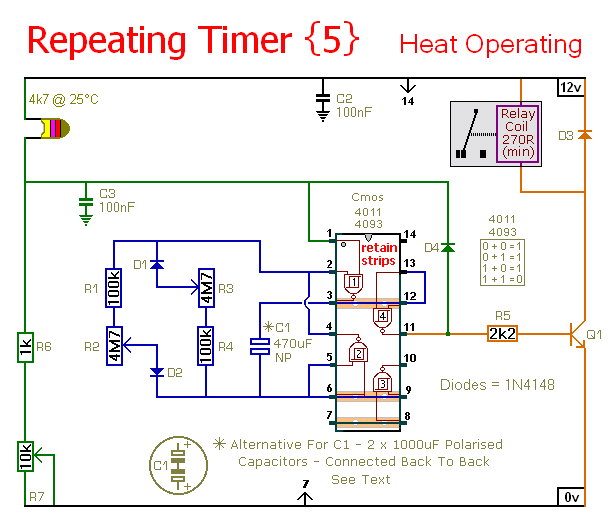
TS555 Timer
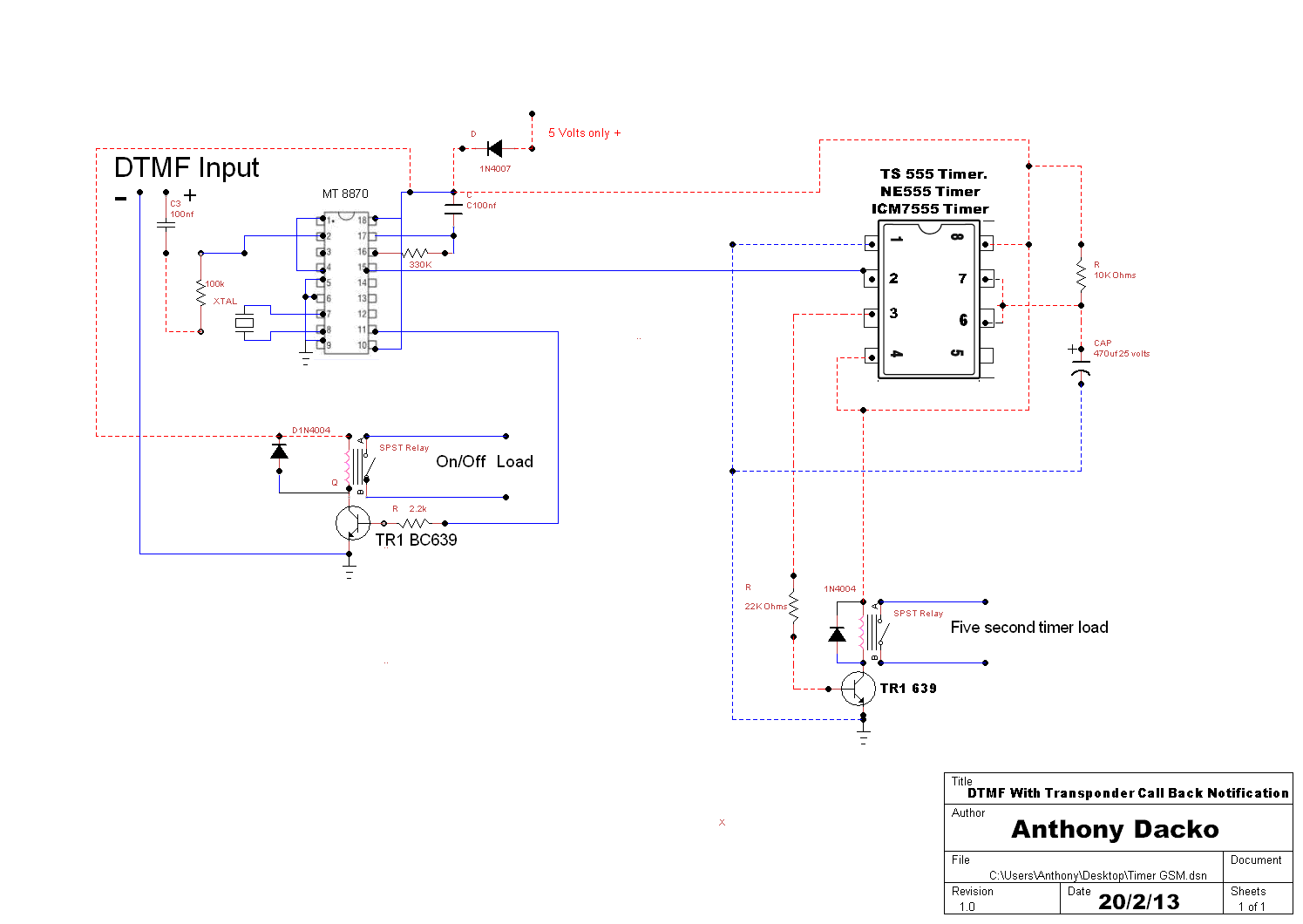
The operation of the circuit is straightforward. When a DTMF tone is sent to the decoder, pin 15 goes high for a brief period, which serves as an effective trigger by supplying a few volts to pin 2 of the 555 Timer. This action triggers the circuit, activating the relay for a short duration. To adjust the timing, one can experiment with R1 by using a potentiometer or a preset resistor. When pin 2 of the 555 Timer receives a few volts at the trigger input, it will switch the relay for approximately 5 seconds. If a one-touch or speed dial is configured on a modified cell phone, it will call to notify that valid DTMF tones have been received. It is advisable to connect this setup to a mobile phone while ensuring that the answering machine is turned off before making the call to the DTMF Decoder, as the calling phone will dial the number stored in its memory. Most cell phones have a 2 to 3-second delay when activating touch or speed dial, and this simple design allows for a 5-second activation before reverting to standby, ready for the next connection to the DTMF device. The design is straightforward, and setting the auto redial feature on the transmitting phone is recommended. The answering machine on the receiving phone should be disabled to prevent it from answering the call. Enabling auto redial on the sending mobile phone is beneficial, as it will re-initiate the call if disconnection does not occur in time, allowing the user to simply disconnect the incoming call, which is displayed on the screen. In this design, a backup modified cell phone is utilized for resending the notification signal. The incoming call does not need to be answered; it can be disconnected without incurring charges. On the receiving mobile phone, the contact can be labeled as "DTMF Call" along with its corresponding number, indicating that the DTMF Decoder has successfully received the command and sent a notification signal. The schematic provided includes a simple timer for the relevant integrated circuits, enabling a load to remain connected until switched off, with the second relay serving as a timer for 5 seconds, designed to send a notification signal confirming the successful reception of the DTMF signal.
The described circuit utilizes a 555 Timer IC configured in monostable mode, which is triggered by the high signal from the DTMF decoder. The DTMF decoder interprets the tones and sends a signal to pin 15, which, when activated, causes a momentary high voltage at pin 2 of the 555 Timer. This triggers the timer, resulting in the relay being engaged for a predetermined duration, typically set to 5 seconds. The timing can be adjusted by altering the resistance value of R1, allowing for flexibility in the duration of the relay activation.
The relay serves as a switch that can control various devices or send notifications, making this circuit suitable for applications requiring remote signaling or alerts. The use of a modified cell phone as part of the notification system adds an additional layer of functionality, enabling it to call a designated number when the DTMF tone is detected.
The design emphasizes the importance of disabling the answering machine on the receiving phone to ensure that the notification call is not missed. The incorporation of an auto redial feature on the sending phone further enhances reliability, ensuring that the notification is received even if the initial call is not answered.
Overall, this circuit is an effective solution for implementing a notification system based on DTMF tones, providing a simple yet efficient method for remote communication and alerting.How the circuit works is simple when you send a DTMF tone to the decoder the value of pin 15 goes high for a short time this makes an excellent trigger as it supplies a few volts to pin 2 of the 555 Timer this triggers the circuit and turned the relay on for a short time. If you want different times you can experiment with R1 use a Potentiometer or a preset one. 3). Now as soon as Pin 2 on the 555 Timer has a few volts at the Trigger input of pin 2 this will switch the relay over for about 5 seconds if you have set one touch dial or speed dial on your Modified Cell phone then this will call you letting you know it has received valid DTMF tones. 4). It would be best to have this go to a mobile phone if you are still connected to the DTMF Decoder then it would be best to turn your Answer phone off before you make the call to the DTMF Decoder as the sending back phone will call what number is locked in it`s memory.
5). Now most Cell phones have a time delay of 2 or 3 seconds when touch or speed dial is activated this simple design gives you 5 seconds then it switches back waiting for the next time you connect to the DTMF Devise to activate it again. 6). The design is simple to follow it would be a good idea if you set on the transmitting phone the Auto Re-dial you have to turn your answer phone off on your receiving phone just in case it went to answer phone.
7). Now setting the Auto Redial on the sending back mobile phone is good as if you did not disconnect in time it will just phone your again then you just disconnect the incoming call as it has showed on your Screen what call is coming in. 8). In this design I have used a back up Modified cell phone for the Re-sending of the notification signal to me the incoming call does not need to be answered just disconnect the incoming call and you will not be charged for the call.
9). On your receiving Mobile phone put the name in like DTMF Call and it`s number this is letting you know the DTMF Decoder received your command and has sent you a notification signal. In the Schematic below I have designed a simple timer for the following IC`s this will allow a load to be connected till switched off or on the second relay is a Timer for 5 seconds, I designed this to send a notification signal to let me know my DTMF signal was received ok.
🔗 External reference
The described circuit utilizes a 555 Timer IC configured in monostable mode, which is triggered by the high signal from the DTMF decoder. The DTMF decoder interprets the tones and sends a signal to pin 15, which, when activated, causes a momentary high voltage at pin 2 of the 555 Timer. This triggers the timer, resulting in the relay being engaged for a predetermined duration, typically set to 5 seconds. The timing can be adjusted by altering the resistance value of R1, allowing for flexibility in the duration of the relay activation.
The relay serves as a switch that can control various devices or send notifications, making this circuit suitable for applications requiring remote signaling or alerts. The use of a modified cell phone as part of the notification system adds an additional layer of functionality, enabling it to call a designated number when the DTMF tone is detected.
The design emphasizes the importance of disabling the answering machine on the receiving phone to ensure that the notification call is not missed. The incorporation of an auto redial feature on the sending phone further enhances reliability, ensuring that the notification is received even if the initial call is not answered.
Overall, this circuit is an effective solution for implementing a notification system based on DTMF tones, providing a simple yet efficient method for remote communication and alerting.How the circuit works is simple when you send a DTMF tone to the decoder the value of pin 15 goes high for a short time this makes an excellent trigger as it supplies a few volts to pin 2 of the 555 Timer this triggers the circuit and turned the relay on for a short time. If you want different times you can experiment with R1 use a Potentiometer or a preset one. 3). Now as soon as Pin 2 on the 555 Timer has a few volts at the Trigger input of pin 2 this will switch the relay over for about 5 seconds if you have set one touch dial or speed dial on your Modified Cell phone then this will call you letting you know it has received valid DTMF tones. 4). It would be best to have this go to a mobile phone if you are still connected to the DTMF Decoder then it would be best to turn your Answer phone off before you make the call to the DTMF Decoder as the sending back phone will call what number is locked in it`s memory.
5). Now most Cell phones have a time delay of 2 or 3 seconds when touch or speed dial is activated this simple design gives you 5 seconds then it switches back waiting for the next time you connect to the DTMF Devise to activate it again. 6). The design is simple to follow it would be a good idea if you set on the transmitting phone the Auto Re-dial you have to turn your answer phone off on your receiving phone just in case it went to answer phone.
7). Now setting the Auto Redial on the sending back mobile phone is good as if you did not disconnect in time it will just phone your again then you just disconnect the incoming call as it has showed on your Screen what call is coming in. 8). In this design I have used a back up Modified cell phone for the Re-sending of the notification signal to me the incoming call does not need to be answered just disconnect the incoming call and you will not be charged for the call.
9). On your receiving Mobile phone put the name in like DTMF Call and it`s number this is letting you know the DTMF Decoder received your command and has sent you a notification signal. In the Schematic below I have designed a simple timer for the following IC`s this will allow a load to be connected till switched off or on the second relay is a Timer for 5 seconds, I designed this to send a notification signal to let me know my DTMF signal was received ok.
🔗 External reference
Warning: include(partials/cookie-banner.php): Failed to open stream: Permission denied in /var/www/html/nextgr/view-circuit.php on line 713
Warning: include(): Failed opening 'partials/cookie-banner.php' for inclusion (include_path='.:/usr/share/php') in /var/www/html/nextgr/view-circuit.php on line 713
